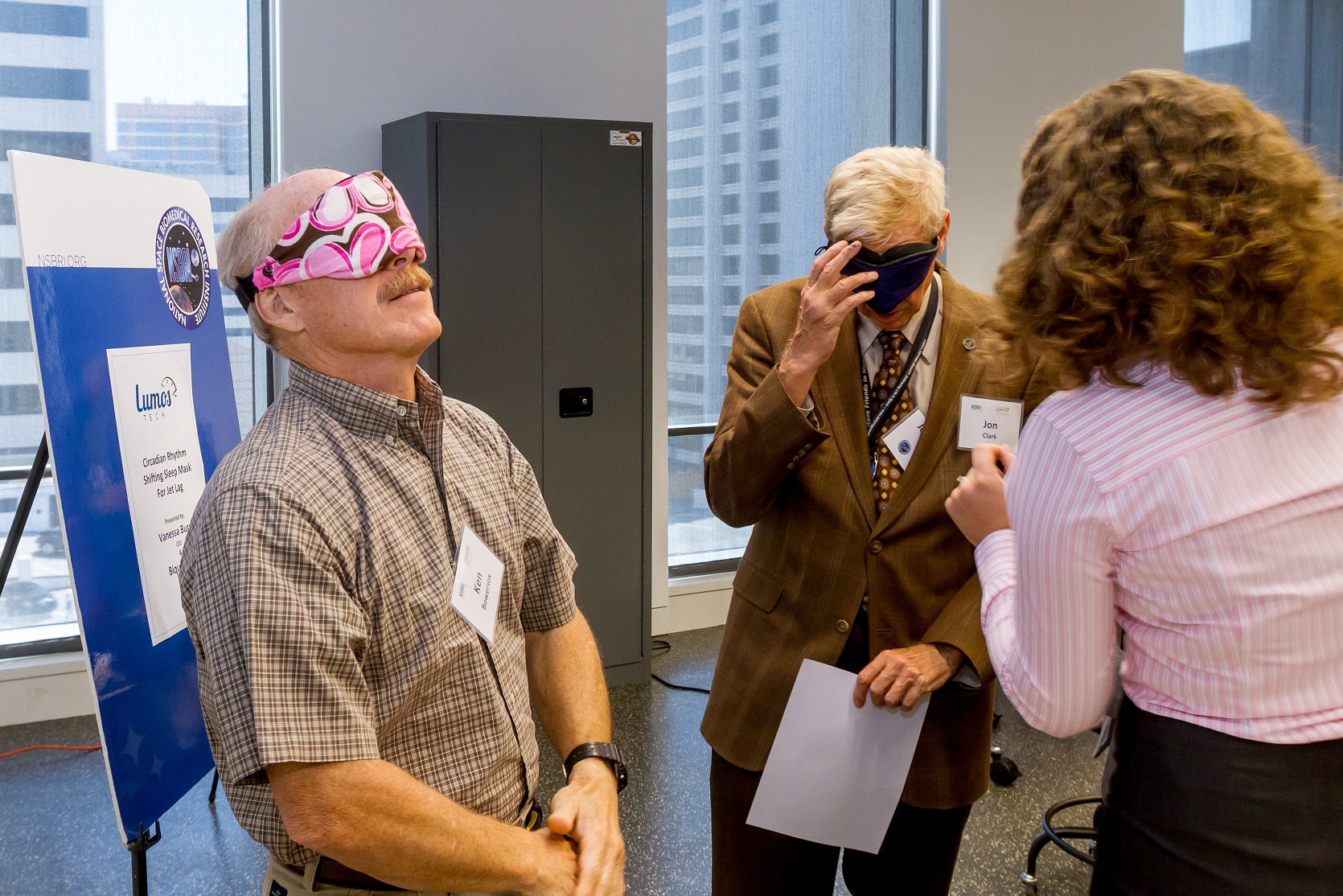With SMARTCAP funding, LumosTech, Inc., is developing a smart sleep mask capable of rapidly realigning circadian phase of the user during sleep. The mask will be controlled with a companion smartphone app and deliver short light pulses during the night to advance or delay the biological clock. During this project, our team will develop custom hardware to deliver light pulses, an engineered textile outer that is functional and comfortable for the user, and a companion smartphone app to enable ease of use. This smart wearable device can help astronauts optimize their sleep schedules in the absence of natural light, assist ground crew adjusting to work-related sleep changes, and increase alertness after wake-up.
Overview
LumosTech Smart Sleep Mask for Circadian Realignment in Space and on Earth

Former astronaut Ken Bowersox wears a prototype version of the LumosTech sleep mask.
Principal Investigator:
Vanessa Burns
Organization:
Lumos Tech, Inc.
Technical Summary
Living and working in space is incongruent with normal entrainment of the human circadian clock. Astronauts on the International Space Station (ISS) can be exposed to up to 16 sunrises and sunsets during each 24-hour cycle. Additionally, extended time in a 24.6-hour Martian day will significantly impact circadian rhythm. This misalignment between the internal circadian clock and mission schedules can lead to poor sleep, impaired vigilance, reduced cognitive and work performance, increased risk for operation error, and a myriad of psychological distresses. While astronauts are allotted more than 8 out of each 24 hours to sleep, they often sleep less than six hours, and frequently rely on pharmacological sleep aids. Furthermore, individual crew members on the ground may have to sleep at different times or have variable circadian rhythms. Thus, there is a significant need to personalize sleep timing in space.
The use of continuous bright light to shift circadian rhythm is well established, but is disruptive to daily activities and misses the circadian clock’s peak sensitivity, which most often occurs during sleeping hours. Recent research has demonstrated the effectiveness of short light pulses to alter circadian phase during sleep in human subjects. Two-millisecond light flashes administered during sleep penetrate the eyelids and change circadian timing without interfering with sleep quality. Due to the properties of the retinal cells that transduce light information to the circadian system, these millisecond light flashes match or exceed the effectiveness of continuous bright light to shift circadian phase. More than 1.5 hours of phase shift can be generated with just over 1 total second of light exposure during one hour.
LumosTech is developing a smart sleep mask that contains bright LEDs able to emit a range of millisecond light pulses at several frequencies. Light timing is controlled by a smartphone app that uses a proprietary algorithm to calculate the frequency and duration required for shifting circadian phase. The light stimulation is delivered during sleep in conjunction with a mathematical model of circadian phase to advance or delay sleep cycles. The mask contains additional LEDs that provide a red-wavelength dawn simulator to stimulate the release of cortisol; this promotes alertness and enhances mood immediately after wakeup. At the end of this funding period we will have consumer-ready prototypes for use on the ISS, in ground-crew shift workers, and in other Earth-side markets.
Earth Applications
Sleep disruption frequently occurs as a result of circadian rhythm misalignment - after traveling several time zones (e.g., jet lag), with shift-work, or other lack of synchrony between the circadian biological clock to daily work/school schedules (social jet lag). Approximately 80% of people have work or school schedules that are out of sync with their biological circadian rhythms. Current light therapy requires sitting in front of a continuous bright light for 1-3 daytime hours. People often use sleeping pills (addictive and numerous side effects) or melatonin supplements (ineffective) because current light therapy options are so inconvenient.
Our technology is superior in that it is effective during sleep without causing sleep disruptions, and uses millisecond light pulses, reducing side effects from continuous bright light therapy, such as headaches and strained eyes. Until now, there has been no convenient and effective solution to help people take control of their sleep. Our technology is superior in that it is effective during sleep without causing sleep disruptions, and uses millisecond light pulses, reducing side effects from continuous bright light therapy, such as headaches and strained eyes.





